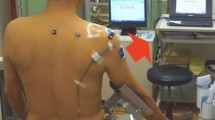Abstract
The rotator cuff is loaded under static as well as dynamic conditions. Whilst the static properties of the rotator cuff muscle-tendon junctions have been reported, the dynamic mechanical behaviour has not. This study reports the dynamic mechanical properties with varying abduction angles in a human cadaver rotator cuff. No significant effect was found with varying the angle of testing or in the presence of a tear in the tendon. The supraspinatus was found to be the stiffest of the rotator cuff tendons followed by the subscapularis and infraspinatus.


Similar content being viewed by others
References
Apreleva M, Parsons IM, Warner JJ, Fu FH, Woo SL (2000) Experimental investigation of reaction forces at the glenohumeral joint during active abduction. J Shoulder Elbow Surg 9:409–417
Bey MJ, Ramsey ML, Soslowsky LJ (2002) Intratendinous strain fields of the supraspinatus tendon: effect of a surgically created articular-surface rotator cuff tear. J Shoulder Elbow Surg 11:562–569
Bey MJ, Song HK, Wehrli FW, Soslowsky LJ (2002) Intratendinous strain fields of the intact supraspinatus tendon: the effect of glenohumeral joint position and tendon region. J Orthop Res 20:869–874
Burkhart SS, Johnson TC, Wirth MA, Athanasiou KA (1997) Cyclic loading of transosseous rotator cuff repairs: tension overload as a possible cause of failure. Arthroscopy 13:172–176
Clark JM, Harryman DT (1992) Tendons, ligaments, and capsule of the rotator cuff. Gross and microscopic anatomy. J Bone Joint Surg Am 74:713–725
Dowling BA, Dart AJ, Hodgson DR, Rose RJ, Walsh WR (2002) Recombinant equine growth hormone does not affect the in vitro biomechanical properties of equine superficial digital flexor tendon. Vet Surg 31:325–330
Dowling BA, Dart AJ, Hodgson DR, Rose RJ, Walsh WR (2002) The effect of recombinant equine growth hormone on the biomechanical properties of healing superficial digital flexor tendons in horses. Vet Surg 31:320–324
Fukuda H, Hamada K, Nakajima T, Tomonaga A (1994) Pathology and pathogenesis of the intratendinous tearing of the rotator cuff viewed from en bloc histologic sections. Clin Orthop 60–67
Gerber C, Schneeberger AG, Beck M, Schlegel U (1994) Mechanical strength of repairs of the rotator cuff. J Bone Joint Surg Br 76:371–380
Halder A, Zobitz ME, Schultz F, An KN (2000) Mechanical properties of the posterior rotator cuff. Clin Biomech (Bristol, Avon) 15:456–462
Itoi E, Berglund LJ, Grabowski JJ, Schultz FM, Growney ES, Morrey BF, An KN (1995) Tensile properties of the supraspinatus tendon. J Orthop Res 13:578–584
Jozsa L, Kannus P (1997) Human tendons: anatomy, physiology and pathology. Human Kinetics, Chicago
Liu J, Hughes RE, Smutz WP, Niebur G, Nan-An K (1997) Roles of deltoid and rotator cuff muscles in shoulder elevation. Clin Biomech (Bristol, Avon) 12:32–38
Nicklin S, Waller C, Walker P, Chung WK, Walsh WR (2000) In vitro structural properties of braided tendon grafts. Am J Sports Med 28:790–793
Parsons IM, Apreleva M, Fu FH, Woo SL (2002) The effect of rotator cuff tears on reaction forces at the glenohumeral joint. J Orthop Res 20:439–446
Riemersa DJ, Schamhardt HC (1982) The cryo-jaw, a clamp designed for in vitro rheology studies of horse digital flexor tendons. J Biomech 15:619–620
Riley GP, Harrall RL, Constant CR, Chard MD, Cawston TE, Hazleman BL (1994) Glycosaminoglycans of human rotator cuff tendons: changes with age and in chronic rotator cuff tendinitis. Ann Rheum Dis 53:367–376
Rossouw DJ, McElroy BJ, Amis AA, Emery RJ (1997) A biomechanical evaluation of suture anchors in repair of the rotator cuff. J Bone Joint Surg Br 79:458–461
Sharkey NA, Smith TS, Lundmark DC (1995) Freeze clamping musculo-tendinous junctions for in vitro simulation of joint mechanics. J Biomech 28:631–635
Warner JJ, Bowen MK, Deng X, Torzilli PA, Warren RF (1999) Effect of joint compression on inferior stability of the glenohumeral joint. J Shoulder Elbow Surg 8:31–36
Woo SL, Orlando CA, Camp JF, Akeson WH (1986) Effects of postmortem storage by freezing on ligament tensile behavior. J Biomech 19:399–404
Author information
Authors and Affiliations
Corresponding author
Rights and permissions
About this article
Cite this article
Nightingale, E.J., Allen, C.P., Sonnabend, D.H. et al. Mechanical properties of the rotator cuff: response to cyclic loading at varying abduction angles. Knee Surg Sports Traumatol Arthrosc 11, 389–392 (2003). https://doi.org/10.1007/s00167-003-0404-5
Received:
Accepted:
Published:
Issue Date:
DOI: https://doi.org/10.1007/s00167-003-0404-5




